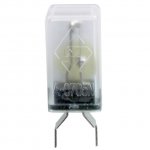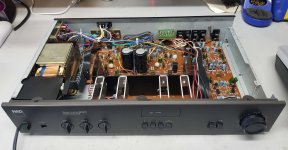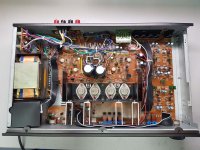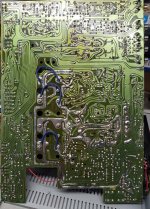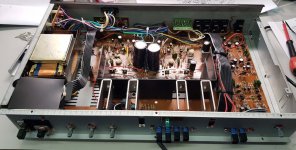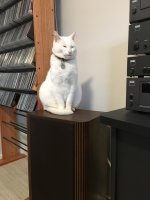Hi all, I have this old NAD 3020 which I am refurbishing. I want to recap it with Nichicon audio quality caps, but I am not sure exactly which caps to do. I am sure lots of people already did this and might still have a list of which caps to replace. If so please pass it on as well as any other tips and advice would be appreciated.
Thanks in advance.
Thanks in advance.
Hi all, I have this old NAD 3020 which I am refurbishing. I want to recap it with Nichicon audio quality caps, but I am not sure exactly which caps to do. I am sure lots of people already did this and might still have a list of which caps to replace. If so please pass it on as well as any other tips and advice would be appreciated.
Thanks in advance.
I've done it and you pass the link :
http://www.diyaudio.com/forums/solid-state/93852-nad-3020-amp-upgrades.html
Full Read it, especially the link attached. ( Piercarlo )
It's not always best to replace the power supply capacitors for larger values, it is a common mistake, but no technical grip. Replace itself is good for better quality or when they are at a loss ...
I wish you luck, it is a very good amplifier, when he was released, he knew demolish many myths ..... a real killer of bigs ....
At the age of these old beasts, you should be replacing every electrolytic but fit non-polarized types for the low value signal coupling caps, if available. Nothing fancy is needed here as chasing super performance will not yield better audio than any other new caps. Just use appropropriate, good quality parts from Panasonic, Rubycon, Nippon chemicon, Nichicon etc.
Always remember that these products became popular because they were very cheap yet full of crappy quality parts and construction methods. The synergy made them a legend but exposing their weaknesses by fitting higher performance parts may seem immediately impressive whilst really no better than new condition, IMV.
There are dozens of versions s of the original 3020 model, so make sure you have the correct manual if using the parts list for ordering.
Start with the main (largest) power supply electros. Then, may I suggest changing caps in stages, one channel at a time where possible and check function as you proceed, since it's easy to make errors with so many operations and having a working channel for reference may save a lot of angst.
Always remember that these products became popular because they were very cheap yet full of crappy quality parts and construction methods. The synergy made them a legend but exposing their weaknesses by fitting higher performance parts may seem immediately impressive whilst really no better than new condition, IMV.
There are dozens of versions s of the original 3020 model, so make sure you have the correct manual if using the parts list for ordering.
Start with the main (largest) power supply electros. Then, may I suggest changing caps in stages, one channel at a time where possible and check function as you proceed, since it's easy to make errors with so many operations and having a working channel for reference may save a lot of angst.
Simply, just those electros under 10uF in the preamp, tone control sections and input stage of the power amplifier. Here is a link to a service manual schematic (free subscription) for the first 3020 and also 3020A model, though that is not referred to. It is item 5 in the download menu, titled "schematic". NAD 3020 Manual - Stereo Integrated Amplifier - HiFi Engine
Following through the left channel from Phono preamp through preamp and tone controls to amplifier input stage, You have odd numbers C401,421,519,601,603,613.
Obviously, the right channel has the next even numbers C402,422 etc. I may have missed some but surely you get the picture.
I would buy Panasonic grades FC or FM for other caps and TSHA grade for the big Electros. All decent manufacturers have near equivalents to these if you have to use other suppliers. Most new electrolytics will be way smaller than the originals so ensure by measurement that the pin/lead spacings will fit and don't be tempted to oversize the main caps just because you can. It doesn't help here but there is little harm in using the next value up if that is all you can buy.
RS and Element14 have quite a range of caps but usually have to airfreight something or other from the UK - they are those kinds of company that cut costs at the price of customer service, lost business opportunities and high freight penalties.
Try Altronics for the signal caps. Use the highest voltage options that fit the space. http://www.altronics.com.au/electronic-components/capacitors/?type_1=bipolar Altronics sell only the unfamiliar Taiwanese "Lelon" brand in fairly standard grades, which may be fine but I can't recommend them as I haven't used them for many years.
Following through the left channel from Phono preamp through preamp and tone controls to amplifier input stage, You have odd numbers C401,421,519,601,603,613.
Obviously, the right channel has the next even numbers C402,422 etc. I may have missed some but surely you get the picture.
I would buy Panasonic grades FC or FM for other caps and TSHA grade for the big Electros. All decent manufacturers have near equivalents to these if you have to use other suppliers. Most new electrolytics will be way smaller than the originals so ensure by measurement that the pin/lead spacings will fit and don't be tempted to oversize the main caps just because you can. It doesn't help here but there is little harm in using the next value up if that is all you can buy.
RS and Element14 have quite a range of caps but usually have to airfreight something or other from the UK - they are those kinds of company that cut costs at the price of customer service, lost business opportunities and high freight penalties.
Try Altronics for the signal caps. Use the highest voltage options that fit the space. http://www.altronics.com.au/electronic-components/capacitors/?type_1=bipolar Altronics sell only the unfamiliar Taiwanese "Lelon" brand in fairly standard grades, which may be fine but I can't recommend them as I haven't used them for many years.
Something to be wary of in replacing components soldered directly to the PCB is the rather "budget conscious" quality of board traces and solder eyelets. I'd use solderwick, and be careful about excessive rocking or twisting to remove any part - those traces are easily lifted or broken, and can be a nightmare to repair.
It is a very good advice. The PCB is not of the quality you might want to go changing components if you do not have a great experience in the field.
I do not think about changing components unnecessarily. Perhaps we will discover the musical nirvana? Much myth around here. To approach the nirvana we go to for a good speakers, and if you already have them, go for a Class A or a valve that engages well with them ....
Moreover, I do not agree that all components were ****. It became cheaper in all that was necessary to lower the cost but always in pursuit of a better quality of sound. The development of the circuit was excellent. I met many people who sold their beautiful amplifiers, silver and enormous level meters and bought this garbage .... I was one of them. There is a fad in the recap this ..... I noticed my NAD3020 after nearly 40 years and the only thing that broke were the electrolytic capacitors power supply .....
An electrolyte is more easily damaged by lack of use for prolonged use ...... never had in their hands a booklet of old flash? Metz, for instance ... Keep using your flash! By deformation of the dielectric capacitor ...
Sorry for the bad English. I use translator
I do not think about changing components unnecessarily. Perhaps we will discover the musical nirvana? Much myth around here. To approach the nirvana we go to for a good speakers, and if you already have them, go for a Class A or a valve that engages well with them ....
Moreover, I do not agree that all components were ****. It became cheaper in all that was necessary to lower the cost but always in pursuit of a better quality of sound. The development of the circuit was excellent. I met many people who sold their beautiful amplifiers, silver and enormous level meters and bought this garbage .... I was one of them. There is a fad in the recap this ..... I noticed my NAD3020 after nearly 40 years and the only thing that broke were the electrolytic capacitors power supply .....
An electrolyte is more easily damaged by lack of use for prolonged use ...... never had in their hands a booklet of old flash? Metz, for instance ... Keep using your flash! By deformation of the dielectric capacitor ...
Sorry for the bad English. I use translator
Just finished replacing the caps in my 3020B.
I haven't yet changed over the large (25mm dia) 4700µF 50V electrolytics. I did everything else though.
I used caps that were in my parts bin - predominantly Panasonic FC or FM - and went up at least one voltage grade to ensure they were mechanically big enough, as newer caps are much smaller than old ones. I stuck to the original value, except for the caps around the preamp regulator - here I went 1000µF 50V for C905 & C906 (originally 330µF 50V), 220µF 50V for C907 & C908 (originally 47µF 50V), 22µF 50V for C911 & C912 (originally 4.7µF 50V), and 220µF 50V for C913 & C914 (originally 47µF 50V).
I also swapped out some of the coupling caps for 5mm pitch MKS poly ones. Here I made the following substitutions: C401 & C402 - 1µ MKS (originally 4µ7), C421 & C422 - 1µ5 MKS (originally 10µ), C519 & C520 - 4µ7 MKS (originally 100µ), C601-604 - 1µ MKS (originally 1µ), C613 & C614 - 4µ7 (originally 47µ).
I also swapped the two 680n electrolytics in the bass circuit for 680n MKS parts. I can't remember their part numbers and they're not in the schematic I have, which is for a 3120 without tone controls.
The result is pretty good. I'd assumed the slight hum this amp always had was normal - turns out it isn't - it's dead quiet. I can barely hear hum with my HD595 cans plugged into the headphone socket and the volume wound right up.
Also I'd always seen a few dB bass boost - It turns out this must have been due to dried out electrolytics, because it's now flat within 1dB from 20Hz to 20KHz with the tone controls centered.
I also did a quick THD measurement to see if there was any improvement from removing electrolytics from the signal path - at 5V RMS out into 8Ω, I get -80dB H2, and H3 onward below the noise at -100dB. That's a reasonably credible 0.01%, so not too shabby I reckon.
Anyway my old 3020B is now literally better than new.
I haven't yet changed over the large (25mm dia) 4700µF 50V electrolytics. I did everything else though.
I used caps that were in my parts bin - predominantly Panasonic FC or FM - and went up at least one voltage grade to ensure they were mechanically big enough, as newer caps are much smaller than old ones. I stuck to the original value, except for the caps around the preamp regulator - here I went 1000µF 50V for C905 & C906 (originally 330µF 50V), 220µF 50V for C907 & C908 (originally 47µF 50V), 22µF 50V for C911 & C912 (originally 4.7µF 50V), and 220µF 50V for C913 & C914 (originally 47µF 50V).
I also swapped out some of the coupling caps for 5mm pitch MKS poly ones. Here I made the following substitutions: C401 & C402 - 1µ MKS (originally 4µ7), C421 & C422 - 1µ5 MKS (originally 10µ), C519 & C520 - 4µ7 MKS (originally 100µ), C601-604 - 1µ MKS (originally 1µ), C613 & C614 - 4µ7 (originally 47µ).
I also swapped the two 680n electrolytics in the bass circuit for 680n MKS parts. I can't remember their part numbers and they're not in the schematic I have, which is for a 3120 without tone controls.
The result is pretty good. I'd assumed the slight hum this amp always had was normal - turns out it isn't - it's dead quiet. I can barely hear hum with my HD595 cans plugged into the headphone socket and the volume wound right up.
Also I'd always seen a few dB bass boost - It turns out this must have been due to dried out electrolytics, because it's now flat within 1dB from 20Hz to 20KHz with the tone controls centered.
I also did a quick THD measurement to see if there was any improvement from removing electrolytics from the signal path - at 5V RMS out into 8Ω, I get -80dB H2, and H3 onward below the noise at -100dB. That's a reasonably credible 0.01%, so not too shabby I reckon.
Anyway my old 3020B is now literally better than new.
Last edited:
Nice result - worth saying so because many fanciful NAD refurbs wind up  but even an as-new restored 3020 sounds rather good.
but even an as-new restored 3020 sounds rather good.
On a related matter, I have never seen the thermal protection relays discussed or referred to in NAD3020 threads, yet twice found burned ones in 3020B, IIRC. These are very cheaply constructed parts with contacts that burn easily as they slowly open and close during prolonged audio overloads. This seems to occur when the little amplifier is worked particularly hard at parties or users are careless with shorting speaker leads or solid metal banana plugs.
Some PCB mounting circuit breakers are still available for replacement but in any case, I'd like to see these eliminated. Something as simple as a wire fuse is just another can of worms though - too low is a nuisance that introduces fuse thermal distortion and too high doesn't protect what it's there for
 but even an as-new restored 3020 sounds rather good.
but even an as-new restored 3020 sounds rather good.On a related matter, I have never seen the thermal protection relays discussed or referred to in NAD3020 threads, yet twice found burned ones in 3020B, IIRC. These are very cheaply constructed parts with contacts that burn easily as they slowly open and close during prolonged audio overloads. This seems to occur when the little amplifier is worked particularly hard at parties or users are careless with shorting speaker leads or solid metal banana plugs.
Some PCB mounting circuit breakers are still available for replacement but in any case, I'd like to see these eliminated. Something as simple as a wire fuse is just another can of worms though - too low is a nuisance that introduces fuse thermal distortion and too high doesn't protect what it's there for

Attachments
Sounds like a great result!
I just recapped an (auction site) special NAD 3225pe as a side project and am pretty pleased with the results. Just under 50 electrolytic capacitors to change out in total I think it was.
I didn't tinker with the values at all, apart from substituting the 0.68uf 50v for some 0.47uf at the low pass filter network (availability issues).
$25 for genuine, reasonable quality caps (nothing too flash needed for my intended use) and under 2 hour labour total to complete was pretty worth it. I too had a bit of hum but she's pretty clean now!
Hunting for some speakers to match this one now...
I just recapped an (auction site) special NAD 3225pe as a side project and am pretty pleased with the results. Just under 50 electrolytic capacitors to change out in total I think it was.
I didn't tinker with the values at all, apart from substituting the 0.68uf 50v for some 0.47uf at the low pass filter network (availability issues).
$25 for genuine, reasonable quality caps (nothing too flash needed for my intended use) and under 2 hour labour total to complete was pretty worth it. I too had a bit of hum but she's pretty clean now!
Hunting for some speakers to match this one now...
Attachments
the price of postage to outer woop-woop where I live is more than what they want for the gear
Even in 'the big smoke', some places still try to charge me as 'regional freight'. But every now and then a decent bargain appears
My cat approves of the newly hum-free 3020B.
He looks very content!
Looks like a great setup you have there.
I've created a shared Mouser project which contains replacements for all of the electrolytic caps in a NAD 3020B with 2 x 4700uF PSU caps:
Mouser Electronics, Inc. United Kingdom
The caps are all Nichicon HT and VZ series other than those around the bass control which are Wima MKS2 due to the unavailability of 0.68uF electrolytics.
My intention of posting here is that it could save time for anyone looking to undertake a re-cap of this amp.
The list below can be copied and pasted into a .csv file for opening in Excel.
Hope this is of use to someone.
Cheers
Chris
Symbol,Value,Voltage,Manufacturer,Manf. Part Number,Notes
C401,4.7uF,50V,Nichicon,UKT1H4R7MDD,
C402,4.7uF,50V,Nichicon,UKT1H4R7MDD,
C407,2200uF,6.3V,Nichicon,UKT0J222MPD,
C408,2200uF,6.3V,Nichicon,UKT0J222MPD,
C409,33uF,25V,Nichicon,UKT1E330MDD,
C410,33uF,25V,Nichicon,UKT1E330MDD,
C417,47uF,25V,Nichicon,UKT1E470MDD,
C418,47uF,25V,Nichicon,UKT1E470MDD,
C421,10uF,16V,Nichicon,UKT1C100MDD,
C422,10uF,16V,Nichicon,UKT1C100MDD,
C423,220uF,10V,Nichicon,UKT1A221MED,
C424,220uF,10V,Nichicon,UKT1A221MED,
C513,47uF,10V,Nichicon,UKT1A470MDD,
C514,47uF,10V,Nichicon,UKT1A470MDD,
C517,47uF,25V,Nichicon,UKT1E470MDD,
C518,47uF,25V,Nichicon,UKT1E470MDD,
C519,100uF,10V,Nichicon,UKT1A101MDD,
C520,100uF,10V,Nichicon,UKT1A101MDD,
C525,47uF,10V,Nichicon,UKT1A470MDD,Not listed in service manual.
C526,47uF,10V,Nichicon,UKT1A470MDD,Not listed in service manual.
C529,0.68uF,50V,Wima,MKS2.68/50/10,Value not available as electrolytic. Not listed in service manual.
C530,0.68uF,50V,Wima,MKS2.68/50/10,Value not available as electrolytic. Not listed in service manual.
C531,47uF,100V,Nichicon,UVZ2A470MPD,Value and voltage combination not available in KT series. Service manual states 4.7uF but 47uF fitted.
C532,4.7uF,50V,Nichicon,UVZ1H4R7MDD,Value and voltage combination not available in KT series.
C533,47uF,50V,Nichicon,UKT1H470MED,
C601,1uF,50V,Nichicon,UKT1H010MDD,
C602,1uF,50V,Nichicon,UKT1H010MDD,
C603,1uF,50V,Nichicon,UKT1H010MDD,
C604,1uF,50V,Nichicon,UKT1H010MDD,
C613,47uF,10V,Nichicon,UKT1A470MDD,
C614,47uF,10V,Nichicon,UKT1A470MDD,
C621,1000uF,10V,Nichicon,UKT1A102MPD,
C622,1000uF,10V,Nichicon,UKT1A102MPD,
C625,47uF,25V,Nichicon,UKT1E470MDD,
C626,47uF,25V,Nichicon,UKT1E470MDD,
C701,22uF,10V,Nichicon,UKT1A220MDD,
C702,22uF,10V,Nichicon,UKT1A220MDD,
C703,22uF,10V,Nichicon,UKT1A220MDD,
C704,22uF,10V,Nichicon,UKT1A220MDD,
C803,4.7uF,50V,Nichicon,UVZ1H4R7MDD,Value and voltage combination not available in KT series. Not in audio path. Not listed in service manual.
C805,1uF,50V,Nichicon,UKT1H010MDD,Not listed in service manual.
C901,4700uF,50V,Nichicon,UVZ1H472MRD,Value and voltage combination not available in KT series
C902,4700uF,50V,Nichicon,UVZ1H472MRD,Value and voltage combination not available in KT series
C905,330uF,50V,Nichicon,UKT1H331MPD,
C906,330uF,50V,Nichicon,UKT1H331MPD,
C907,47uF,50V,Nichicon,UKT1H470MED,
C908,47uF,50V,Nichicon,UKT1H470MED,
C911,4.7uF,50V,Nichicon,UKT1H470MED,
C912,4.7uF,50V,Nichicon,UKT1H470MED,
C914,47uF,35V,Nichicon,UKT1V470MDD,
C915,47uF,35V,Nichicon,UKT1V470MDD,
Mouser Electronics, Inc. United Kingdom
The caps are all Nichicon HT and VZ series other than those around the bass control which are Wima MKS2 due to the unavailability of 0.68uF electrolytics.
My intention of posting here is that it could save time for anyone looking to undertake a re-cap of this amp.
The list below can be copied and pasted into a .csv file for opening in Excel.
Hope this is of use to someone.
Cheers
Chris
Symbol,Value,Voltage,Manufacturer,Manf. Part Number,Notes
C401,4.7uF,50V,Nichicon,UKT1H4R7MDD,
C402,4.7uF,50V,Nichicon,UKT1H4R7MDD,
C407,2200uF,6.3V,Nichicon,UKT0J222MPD,
C408,2200uF,6.3V,Nichicon,UKT0J222MPD,
C409,33uF,25V,Nichicon,UKT1E330MDD,
C410,33uF,25V,Nichicon,UKT1E330MDD,
C417,47uF,25V,Nichicon,UKT1E470MDD,
C418,47uF,25V,Nichicon,UKT1E470MDD,
C421,10uF,16V,Nichicon,UKT1C100MDD,
C422,10uF,16V,Nichicon,UKT1C100MDD,
C423,220uF,10V,Nichicon,UKT1A221MED,
C424,220uF,10V,Nichicon,UKT1A221MED,
C513,47uF,10V,Nichicon,UKT1A470MDD,
C514,47uF,10V,Nichicon,UKT1A470MDD,
C517,47uF,25V,Nichicon,UKT1E470MDD,
C518,47uF,25V,Nichicon,UKT1E470MDD,
C519,100uF,10V,Nichicon,UKT1A101MDD,
C520,100uF,10V,Nichicon,UKT1A101MDD,
C525,47uF,10V,Nichicon,UKT1A470MDD,Not listed in service manual.
C526,47uF,10V,Nichicon,UKT1A470MDD,Not listed in service manual.
C529,0.68uF,50V,Wima,MKS2.68/50/10,Value not available as electrolytic. Not listed in service manual.
C530,0.68uF,50V,Wima,MKS2.68/50/10,Value not available as electrolytic. Not listed in service manual.
C531,47uF,100V,Nichicon,UVZ2A470MPD,Value and voltage combination not available in KT series. Service manual states 4.7uF but 47uF fitted.
C532,4.7uF,50V,Nichicon,UVZ1H4R7MDD,Value and voltage combination not available in KT series.
C533,47uF,50V,Nichicon,UKT1H470MED,
C601,1uF,50V,Nichicon,UKT1H010MDD,
C602,1uF,50V,Nichicon,UKT1H010MDD,
C603,1uF,50V,Nichicon,UKT1H010MDD,
C604,1uF,50V,Nichicon,UKT1H010MDD,
C613,47uF,10V,Nichicon,UKT1A470MDD,
C614,47uF,10V,Nichicon,UKT1A470MDD,
C621,1000uF,10V,Nichicon,UKT1A102MPD,
C622,1000uF,10V,Nichicon,UKT1A102MPD,
C625,47uF,25V,Nichicon,UKT1E470MDD,
C626,47uF,25V,Nichicon,UKT1E470MDD,
C701,22uF,10V,Nichicon,UKT1A220MDD,
C702,22uF,10V,Nichicon,UKT1A220MDD,
C703,22uF,10V,Nichicon,UKT1A220MDD,
C704,22uF,10V,Nichicon,UKT1A220MDD,
C803,4.7uF,50V,Nichicon,UVZ1H4R7MDD,Value and voltage combination not available in KT series. Not in audio path. Not listed in service manual.
C805,1uF,50V,Nichicon,UKT1H010MDD,Not listed in service manual.
C901,4700uF,50V,Nichicon,UVZ1H472MRD,Value and voltage combination not available in KT series
C902,4700uF,50V,Nichicon,UVZ1H472MRD,Value and voltage combination not available in KT series
C905,330uF,50V,Nichicon,UKT1H331MPD,
C906,330uF,50V,Nichicon,UKT1H331MPD,
C907,47uF,50V,Nichicon,UKT1H470MED,
C908,47uF,50V,Nichicon,UKT1H470MED,
C911,4.7uF,50V,Nichicon,UKT1H470MED,
C912,4.7uF,50V,Nichicon,UKT1H470MED,
C914,47uF,35V,Nichicon,UKT1V470MDD,
C915,47uF,35V,Nichicon,UKT1V470MDD,
The other thing to watch out for in any NAD amps is dry joints. I've seen a lot particularly when (on some models) the transformer sits on a pcb. I had a NAD2200 with dry joints on the transformer centre tap which caused uneven supplies and a major blowup of the power amps. It was a semiconductor graveyard! Just worth a look while your at it.
Can somebody tell me whats the capacity and voltage of C427 ?
I was searching this capacitor in service manual, but i couldnt find it.
If 3020i or 3225pe, that one is 47uF, 25v, 20%
What version 3020 is yours? If it is 3020B or 3120, C427 is a 50V ceramic cap. 0.0082uF +/-5% according to that particular manual. NAD 3020 - Manual - Stereo Integrated Amplifier - HiFi EngineCan somebody tell me whats the capacity and voltage of C427 ?
What version 3020 is yours? If it is 3020B or 3120, C427 is a 50V ceramic cap. 0.0082uF +/-5% according to that particular manual. NAD 3020 - Manual - Stereo Integrated Amplifier - HiFi Engine
I have the first version of NAD 3020
On the picture bellow you can see this capacitor.
Imgur: The magic of the Internet
An externally hosted image should be here but it was not working when we last tested it.
Last edited:
- Home
- Amplifiers
- Solid State
- NAD 3020 recap
